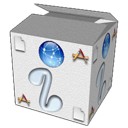
 The i-Package Window
The i-Package Window
When you open a package, you will be presented with a window. This window contains
The action buttons
These are the most important buttons for i-Installer.
If you just want to go ahead and do something, just use the install, configure or remove buttons. When the package is unlocked and network access is enabled, i-Installer will always first check if the remote location contains an updated package and it will offer you the option to update and install in one operation, bypassing the option of inspection before performing the action.
The Readme tab
This one speaks for itself. It is always available. You should always read this before installing a package. Packages are powerful and may be interactive. When you are presented with a sheet asking you for some input, then information on what to do could be in the Readme view.
The Properties tab
The properties tab displays information on the package. These are:
- URL
- Displays the URL where the remote package is located. This location will be used for updates and downloads. You can set this to another URL by pressing the Set Remote URL button next to it.
- Size
- Displays the total size of the package
- Self
- This is the version of the package as it available on your local hard disk (this is not the installed software, but the package itself from which software may be installed). You can update Self from the Remote Package by pressing the Update Self from Remote button next to it. This button is disabled when network access or autodownload have been turned off or when the package is locked. See below for more info.
- Remote Package
- This is the version of the package as it is available at the URL. If the network is down, if network access is restricted this wil display "Could not get remote timestamp". You can reread the remote version by pressing the Re-read Remote Version button next to it. This button is disabled when network access has been turned off. See below for more info.
- Installed
- This is the version of the package that has been used to install the software on your system. If you have never installed this package yet, this will display "No installation found". See below for more info.
- Install Location
- Where the contents of the archive (if any) will be installed. This information is passed on to the scripts. You can set this to a different location if the package is relocatable by using the Change Install Location button next to it.
- Authentication required
- If this package requires administrator access. If it does, it will ask for authentication when install, configure or remove is started. Autentications may expire, so it is possible that you will be asked to re-authenticate at any time during install, especially when you still had to download large archives. Only the prepare, configure and remove scripts and the unarchiving will be executed authenticated. All other processes (like downloads, checks) will run plain. You can turn this off or on at will, so when a package should install in /Library by default (and it thus needs authentication to write there) you might turn it off and set the install location to ~/Library to install it in your own home directory. Note: not all packages work when installed in any location but their official location.
- Interactive
- Warning property. When this is YES, i-Installer will act as a Distributed Objects server to the scripts so they can display messages and present choices in sheets. The DO-server is only active during the running of the scripts.
- Nonstandard files
- Warning property. The standard files are:
- Preparation script (is run before unarchiving on install)
- Archive & cached archive listing
- Configuration script
- Uninstall script
- Info RTF file (Readme)
Is there anything else, there is additional reason to inspect the package contents. For instance, someone could include a doctored version of some system file (as a Trojan horse) to replace the orginal on your system.
The three 'versions' bit may be slightly confusing at first. Just remember that there are three locations for each package. Firstly, the location on the internet where your repository is and where you check for updates and download missing contents from. Secondly, a local copy of that remote location (which may be out of date as well as incomplete). This is the package on your local disk which is used for all local operations like install, remove and configure. And thirdly, what was actually installed from the package on your system. Each of these three may or may not exist. A package can be completely self-sufficient when the remote location is unavailable. And whether the software was installed and configured depends completely on you.
The most confusing, it turns out, is the 'update' button. This does not update the installed software, but it updates "Self", your package on your local disk. And what is more: it will not update the contents at all, it will in fact only remove any part of he package which has changed. This removal-only behaviour is in line with the minimum-network access strategy. Updating a package is not the same as using it. Only when you perform one of the functions, i-Installer will download missing contents for that function. And since updating does not mean also installing (after all, you could be updating because you want access ot an improved remove or configure stage only), you will have the possibility to inspect the package before doing anything with it.
The Output Tab
This tab contains a splitview. The upper part displays the standard output of the scripts and unarchiving processes. The lower part displays the standard error of those processes. These views display the output either in black (for non-authenticated subprocesses) or red (when the output comes from an authenticated subprocess).
The Pkg Contents tab
The Inspect Files tab is used to inspect the package contents. You select a row from the table and you click the Inspect button. The contents of what you inspect are then displayed in the view below. Note: you must hit the inspect button. Simply selecting the row is not enough. The reason is that an inspect might trigger a lengthy download and you do not want to download everything by just traversing the list. The table itself also holds information on the file in the package: A for availability, M for a valid MD5 checksum, S for a valid GPG signature, Name, Size and Type. The Inspect button may change its title to one of the following formats:
- Download & Inspect when the file to be inspected needs to be downloaded first
- In case of an archive, the title is followed by either (Real) when clicking will inspect the real archive and (Cache) when clicking will display the cached listing (which is generally a lot smaller and faster to download). These different modes depend on the Alt key being depressed.
- Unavailable when the file (or in case of an archive either file or separate contents listing) is not available and network access or auto-download have been turned off in preferences. In case network access has not been disabled, but auto-download has been disabled, pressing the Shift key will temporarily enable downloading for this inspect action only.
The Activity tab
This tab contains a list of processes. Download progress can be seen here and all processes that are waiting on the completion of other processes. You can abort activities here.
The Report tab
If something goes wrong or there are problems, you can use the report function to create a full overview of settings and output (so far) for your package. When created, you can mail or print the report. In case of problems, I will really want to see this, because it can give me valuable clues with regard to the problem. There is a shortcut menu item to create and display a report.
The Messages view
Below the tab view, there is a view where i-Installer displays progress messages and warnings of its own. These messages are colour coded. Orange messages are just plain informational status messages. Red messages are warnings and errors.

 The i-Package Window
The i-Package Window

 The i-Package Window
The i-Package Window